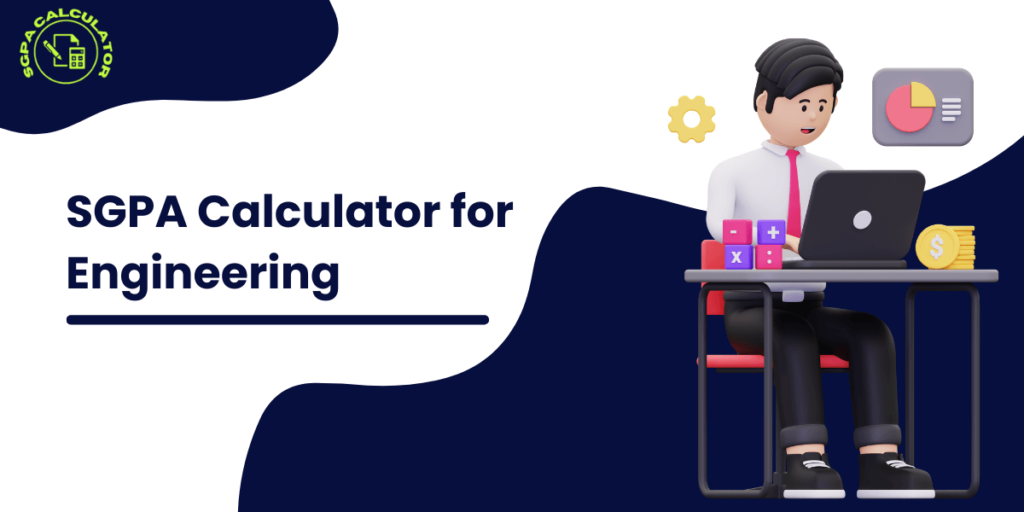Calculating your Semester Grade Point Average (SGPA) is a crucial task in the field of engineering education. An important indicator of a student’s academic success over a given semester is their SGPA. It offers information about a student’s performance in their coursework, assisting them in identifying their strengths and weaknesses. This post will explain what SGPA is, why it’s important, and how to use an SGPA calculator made especially for engineering students to calculate it accurately.
What is SGPA?
The Semester Grade Point Average (SGPA) is a figure that expresses a student’s academic achievement for a specific semester. As a gauge of a student’s overall performance, it is a weighted average of the grade points earned in each individual course. Generally, SGPA is computed on a range of 0 to 10, where 10 denotes exceptional performance and is the highest score.
Read Our Blog: CGPA Calculator for Engineering
Why SGPA Matters
SGPA holds significant importance in the academic and professional lives of engineering students. Here are some key reasons why SGPA matters:
Academic Progress: SGPA helps students track their academic progress from one semester to another. It provides a clear picture of how well they are performing and whether they are meeting the academic requirements of their program.
Scholarship Eligibility: Many scholarships and financial aid programs have minimum SGPA Calculator requirements. Maintaining a good SGPA can make students eligible for these financial incentives.
Job Opportunities: Employers often consider a candidate’s academic performance, including SGPA, when making hiring decisions. A high SGPA can be a competitive advantage in the job market.
Further Education: For students planning to pursue higher education, a strong SGPA can be a deciding factor in getting into prestigious institutions and programs.
Self-Reflection: SGPA allows students to reflect on their strengths and weaknesses in their coursework. It can help them identify areas that need improvement and areas where they excel.
Now that we are aware of the importance of SGPA, let’s examine the specifics of its precise calculation.
How to Calculate SGPA
The method used to calculate a student’s SGPA involves averaging the grade points they receive for each course, which are determined by the student’s performance. The steps involved in calculating SGPA are as follows:
Step 1: Assign Grade Points
Each course is typically assigned a grade point based on the student’s score. The most common scale used for grade points in engineering institutions is as follows:
A+ (Excellent): 10
A (Very Good): 9
B+ (Good): 8
B (Satisfactory): 7
C (Pass): 6
F (Fail): 0
These grade points represent the quality of a student’s performance in a particular course.
Step 2: Calculate Course Credit Points
You must figure out how many course credit points are awarded for each course. The process for doing this is to multiply the course grade point by the total number of credits it carries. To give you an example, if you received a ‘A’ (grade point 9) in a course worth three credits, your course credit points would be nine times three, or 27.
Step 3: Sum of Course Credit Points
Add up all the course credit points for the courses you took in a given semester. This will give you the total credit points for that semester.
Step 4: Calculate Total Credits
Find out the total credits for the semester by adding up the credits for all the courses you took.
Step 5: Calculate SGPA
To calculate your SGPA for the semester, divide the total credit points by the total credits. The formula for SGPA is as follows:
SGPA = Total Credit Points / Total Credits
Using an SGPA Calculator
Even though the manual calculation method is simple, it can get tiresome when there are a lot of courses and credits to take into account. Online SGPA calculators that can do the computations automatically are available to make the process simpler. The purpose of these calculators is to increase process efficiency and decrease error-proneness.
Here’s how to use an SGPA calculator for engineering:
Input Course Details: Start by entering the details of the courses you’ve taken in the semester. This typically includes the course name, credits, and the grade you received.
Automatic Calculation: Once you’ve entered all the course details, the calculator will automatically calculate the course credit points and SGPA for you.
Review Results: The SGPA calculator will provide you with your SGPA for the semester, allowing you to see your performance at a glance.
Benefits of Using an SGPA Calculator
Time-Saving: Calculating SGPA for multiple courses can be time-consuming when done manually. An SGPA calculator saves time and effort.
Accuracy: These calculators eliminate the possibility of calculation errors, ensuring that your SGPA is calculated accurately.
Instant Feedback: With an SGPA calculator, you can quickly see the results of your efforts in a particular semester, allowing for immediate self-assessment.
Planning Tool: SGPA calculators can be used as a planning tool. You can input hypothetical grades to see how they would affect your overall SGPA.
Historical Data: Many SGPA calculators allow you to keep track of your SGPA for each semester, helping you monitor your academic progress over time.
Incorporating an SGPA Calculator into Your Routine
To make the most of an SGPA calculator, consider incorporating it into your academic routine. Here’s how you can use it effectively:
Regular Updates: After each set of exams or when you receive your grades, use the calculator to update your SGPA. This will help you stay informed about your performance.
Goal Setting: Set academic goals for yourself and use the calculator to determine the grades you need to achieve those goals. This can serve as motivation for improvement.
Identify Weaknesses: If you consistently receive low grades in specific courses, use the calculator to identify areas that need improvement. Seek help or additional resources to address those weaknesses.
Plan Ahead: Use the calculator to plan for future semesters. By inputting hypothetical grades, you can set realistic academic goals for upcoming courses.
Conclusion
For engineering students, SGPA is an important statistic that sheds light on their academic achievement. While using an SGPA calculator can make the process simpler and lower the chance of error, knowing how to calculate SGPA manually is still necessary. Through consistent updates and strategic use of an SGPA calculator, learners can track their development, establish learning objectives, and make well-informed choices regarding their assignments. A strong SGPA is a valuable indicator of success for aspiring engineers because it can lead to scholarships, employment, and opportunities for further education in the highly competitive field of engineering education.





